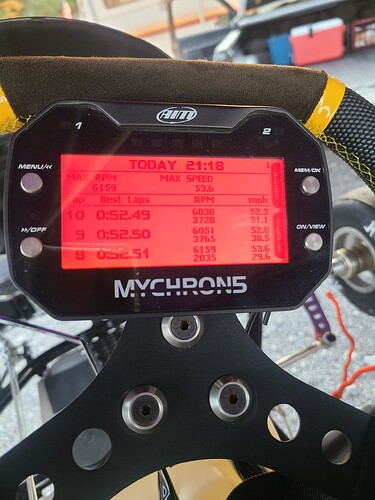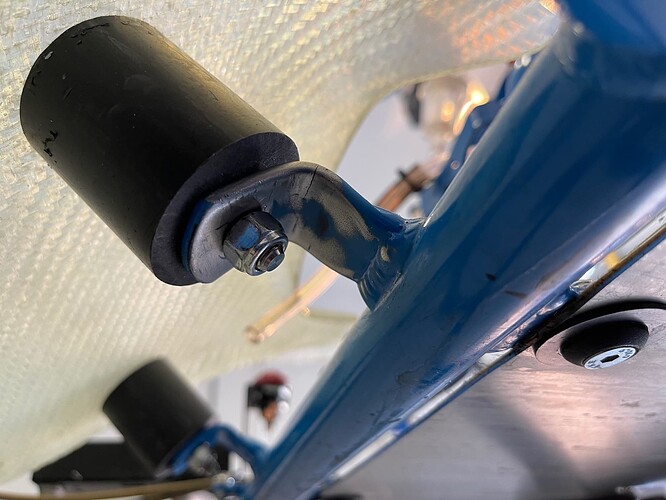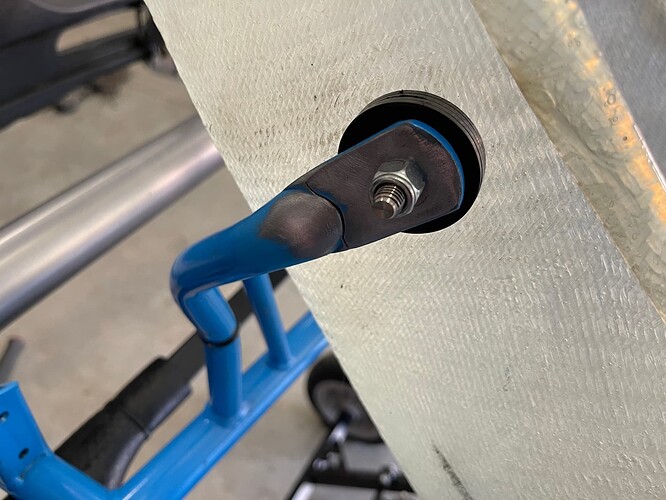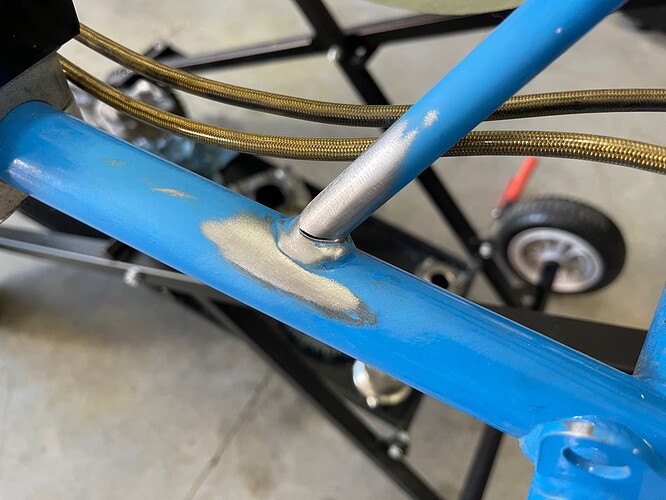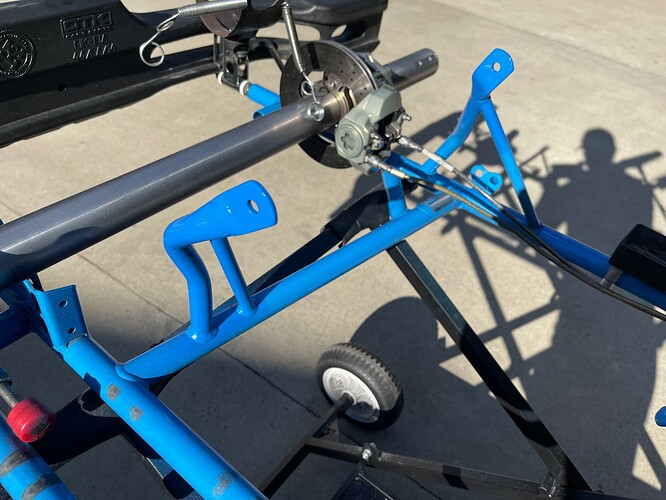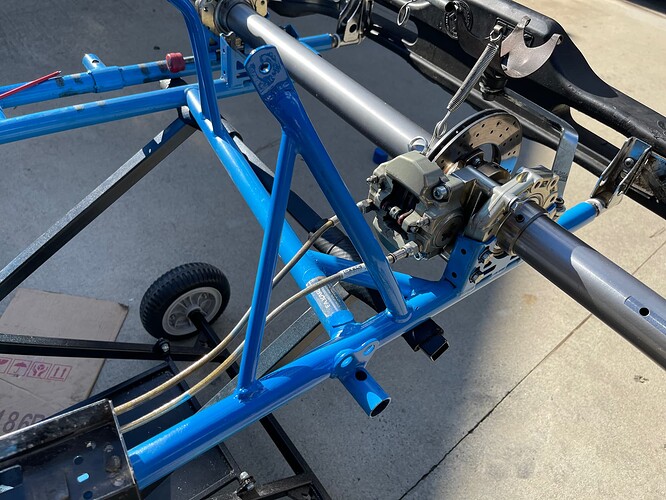For what it’s worth, I was much lower on pressure for every session but the final than you were. Qualifying I went out at 13/12.5. Prefinal 12.5/12. Final 12.3/11.8. I think MCC needs the lower pressure to absorb the bumps.
Thanks Zach, I’ll play around with that. Although I’m guessing it could all be out the window for end of October depending on the temperature.
Thank you to all that have responded. I checked the seat posts and nearby welds as best I could and could not find any evidence of cracking.
Based on the updated seat setup guide I decided to move my seat rearward. The furthest I could reasonably get my OTK size 3 seat back was 655/660mm. I could have likely gone another 5mm, but it would have jammed the flat portion of the non-engine side seat strut inside of the lip on the side of the seat. Not ideal. The other option would have been to space the seat over to the engine side, but I didn’t really like that option either, so went with the 655/660.
I got 4 test sessions with the seat change over the weekend, then a race day. The first session I left everything else the same as last time it ran except that I was on older MGs. I immediately noticed a difference! The rear was much more planted and less likely to come around after turn-in. In fact so much of the balance had changed that I felt like the front had really lost significant steering feel and comparatively it felt like I really had to crank on the wheel to get the front end to set. The next sessions I ended up going back to full width in the rear, then to the Hoosiers I’d be racing on, then finally to put in the front chrome round bar which gave me back the front end feel I was used to without the twitchy rear end. I could still get the rear to slide with hacky throttle application (which I’m guilty of sometimes), but it was MUCH more forgiving.
I also drilled my used Tillett to hopefully test in the future (didn’t have time this outing), and what was interesting is that aligning the holes I had used previously gave me a measurement pretty close to 15-20mm further back than it would have on the old chassis. So I’d say the newer OTKs have extra space between the seat and front hoop somewhere and the new measurements should be considered the proper ones to use.
I’m kicking myself for spending so much time chasing my tail on setup this year and never trying the seat, but I hopefully won’t overlook that option in the future.
So glad to hear you’ve gotten some forward progress now. Hopefully this offers a good baseline now to tweak.
This is a good lesson and another example of “if nothing is working, look at your seating position”.
Did you scale your kart before and after the change? I’m just wandering how much of a percentage change there was.
Also there are length adjustable seat struts so that you don’t have to re-drill your seat.
New guy with dumb question alert! Does it pay dividends to have a local fast guy take a few laps to help diagnose set-up challenges? If the kart can cut lower lap times with someone else behind the wheel, should drivers focus more on technique versus taking a stab at set-up?
This can be a really useful exercise if you’re stumped and don’t know how to go faster. You’ll know right away whether it’s a driving problem or a setup problem if you plop a competent hot shoe in your kart. If they go a fair bit faster than you can, it’s pretty clear then that the setup isn’t the issue. 9 times out of 10 this is what ends up happening.
I always offer to jump in the seat of drivers I’m coaching (assuming I fit), because it also provides a good data set to compare to.
Before moving the seat it was 42.5%-42.7% front weight depending on fuel load, so it didn’t raise any red flags to me. I haven’t had a chance to scale it since, but I’d say it seems in my instance I want it to be a more rearward weight bias.
I may throw the Tillett in there in a further back position during a race weekend just to try it out, but that also throws other variables into the mix and isn’t a direct comparison.
Wow, that sounds right to me also… I wonder what moving the seat back did to the new percentages.
OTK must have made some major changes to the chassis dynamics for such a “big” change.
Really solid drivers are not just fast, they are annoyingly consistent. The gap between their fastest and slowest laps during a session is typically a tenth or two. Experience tells them what lap times to expect, based on track and environmental conditions. And when they touch the kart, it’s for a very specific reason.
Exactly, and that consistency is how they’re able to tune the kart more effectively. Easier to tune something out when you know it’s a kart problem and not a driver problem.
Nice spread. It’s always fun when wierd stuff like that happens.
Speaking of cracked seat struts. My seat was starting to crack and break in all sorts of weird spots. So I went to mount a new one, removed the engine side bolt of the old seat, and the whole seat sprang to the left. The left side mount was pushed over a good ~1.5".Once I got some of the tabs bent back into place the cracks were pretty obvious. Guessing I’ve had busted seat mounts for awhile. Good day to dust of the welder.
It’s weird as last weekend was the fastest I’ve ever been by a significant margin. Almost one of those don’t fix it unless it’s broke situations. 
What year is the chassis? That is a lot cracks. Also, if this is a later OTK kart, the paint can be removed with brake cleaner, no grinding needed just some sanding to clean the area.
I noticed that you are using rubber bushings for the front seat mount spacers. I’ve always used a hard mounting method like a stack of washers.
It’s an ‘18 and I’m not a light guy. Had a couple small side impacts that I’m guessing bent the seat posts so bending them back was too much. Had this frame repowdercoated since the OTK paint was thin.
Also those are Delrin plastic spacers which are quite stiff.
Nothing a welder, sander, and paint can’t fix.
